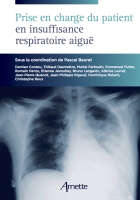(for any order > 35€)
Book written in French
Acute respiratory distress is a clinical situation encountered by many healthcare professionals – from emergency medicine doctors to on-call registrars, critical care doctors and anaesthetists - on a daily basis.
It can be a complication of a wide variety of clinical conditions.
It can arise in patients who do not have an underlying respiratory disorder or as a complication of chronic respiratory failure.
This book deals with its most common forms.
Before treating a patient with acute respiratory failure, doctors must first assess their clinical condition and these underlying factors, start the type of respiratory assistance required and then identify the cause of the failure with a view to treating it.
In some cases, intensive, curative treatment can be considered inappropriate and the aim is then to make the patient as comfortable as possible and relieve his or her respiratory distress.
This is also the case for the terminally ill, in whom signs of acute respiratory failure are common.
TABLE OF CONTENTS :
From physiology to clinical symptoms and signs
- Ventilation
- Types of ARF and pathophysiological mechanisms
- Clinical manifestations of ARF
Ventilation
- Oxygen therapy
- Indications of assisted ventilation
- Assisted ventilation methods
Cardiogenic pulmonary oedema
- Treatment
- Other treatment methods
Acute respiratory failure caused by acute exacerbation of chronic obstructive bronchopulmonary disease
- Causes of decompensation
- Role played by comorbidities
- Utility of biomarkers
- Criteria for seriousness
- Medicinal treatment
- Ventilation
Serious acute community-acquired pneumonia : epidemiology, diagnostic strategy and antibiotic treatment
- Classification and microbial spectrum
- Clinical diagnosis Microbiological diagnosis
- Antibiotic treatment
- Diagnostic pitfalls
Serious chest trauma
- General Role of imaging in the assessment of lesions in patients with chest damage
- Anatomical criteria for assessing the seriousness of chest damage
- Risk factors associated with recourse to mechanical ventilation
- Treatment strategy
- Long term outcomes
Pleural effusion
- Epidemiology
- Treatment
- Equipment
Acute respiratory failure
- Postoperative respiratory failure: deciding factors for surgery and anesthesia
- Risk factors for postoperative respiratory complications
- Procedures and strategies for the prevention of postoperative respiratory failure
Acute respiratory failure caused by neuromuscular disease
- Acute diseases
- Decompensation of chronic neuromuscular disease
Acute respiratory failure: pediatric population
- Specific physiological features in children
- Management of upper airways
- Laryngitis, epiglottitis, tracheitis
- Obstructive respiratory disease
- Pneumonia and pleuropneumonia
- Acute respiratory distress syndrome
- Neuromuscular disease
- Future outlook
Role of physiotherapy
- Clearing the airways
- Aerosol therapy
- Setting up noninvasive ventilation
Palliative approach to acute respiratory failure
- Circumstances – Clinical situations
- Palliative care
- Conclusion and future perspectives
